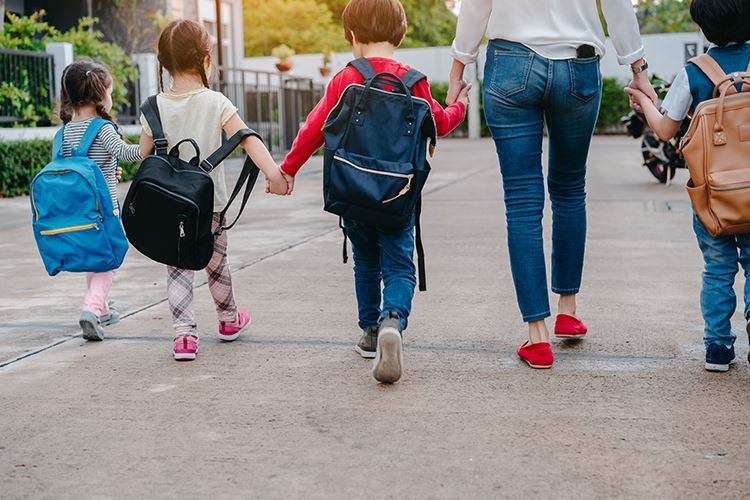A Brief History of the School Backpack

But how did school bags get their start in the world? Is there something that school bags should be doing that they aren’t? Why use a school bag instead of a bag with a different style? In this article, we’ll answer all of these questions and more by giving you a brief tour through the history of the school backpack.
Ancient Backpack Designs
The basic design of the school bag goes back into prehistory. Several ancient cadavers preserved in ice have been documented as carrying small bags made out of animal hides. These cavemen probably weren’t going to school, however.
They did certainly need to carry small materials, though. The earliest discovered bags were much smaller than what we would consider being a school backpack today, capable of only carrying a couple of baseball-sized items.
By the time the Romans got around to innovating on the idea of school bags, there were a handful of new features that had been introduced. First, bags had two straps instead of one. This allowed the weight to be distributed more evenly.
Second, bags could be secured at the top by twisting a wooden piece, then looping it back into a section of fabric or hide. This meant that bags could be closed and protected from the elements. Nonetheless, the Romans weren’t about to be transporting any books in their backpacks.
The backpacks used by the Romans were only for legionnaires, which typically meant that their cargo would be bandages, a spade, and food. Nonetheless, these backpacks were useful enough to be mass produced.
Backpacks Go Modern
Between the era of the Romans and the late Renaissance, backpacks weren’t fundamentally changed. Straps were still made from leathers, and the sack portion of the bags was made of felt, cloth, leathers, or hides.
During the Renaissance, however, increasing affluence and technological competence with metalsmithing led to the easier creation of metal clasps and buckles. This was revolutionary for backpacks, which could now easily have integrated pockets which could be opened and closed more reliably than the wooden stick method.
Making buckles and clasps increased the weight of backpacks, but it also allowed backpacks to get a lot bigger without having to worry about the contents inside becoming one big jumble.
During the Industrial Revolution and after, bags began to be used by children to transport their materials for school. These materials were typically lunch, notebooks, pencils, and perhaps a book or two.
Notably, while the design of backpacks had changed a lot from earlier times, the fundamental style and features of backpacks wouldn’t change very much up through the end of the second World War.
At that point, a lot of materials science advancements had been made relative to the bags of the prior eras which had gradually phased out pelts and hides in favor of tough textiles.
Extrudable plastics which could be woven into fibers, like nylon, revolutionized the entire backpack world.
Many backpacks were not suitable for children because they were made from expensive leathers, leaving children with cloth substitutes of poor quality. Once plastics could be introduced into backpacks, however, children had access to light backpacks that had as many features and as much durability as prior bags.
In the postwar period, backpacks had another major advancement introduced: zippers. While zippers themselves had been invented long before, the lack of articulable metal fabrication and plastic fabrication facilities prevented them from getting widespread adoption.
That, of course, is no longer the case. Once zippers could be reliably mass produced, they quickly became the favored way of closing pockets in backpacks. This also allowed many new backpack designs to proliferate and gave us the semblance of a modern school backpack.
The School Bag Of The Future
The modern school backpack is great for carrying books and lunch, and it’s often fashionable enough for children to stomach. But school backpacks are still imperfect. Carrying heavy loads on most simple school backpacks can be painful, and may cause permanent injury in some cases.
School backpacks typically are held up by their two straps alone. They were never intended to carry heavy weights, but that’s exactly what they have become. As a result, manufacturers have scurried to try to innovate new ways of distributing the load in school bags.
Most methods rely on distributing the weight of the bag from the shoulder straps down to the hips, where there is more load-bearing ability. Modern school backpacks only have a small handful of features which do this in comparison to other bags that are intended for serious load bearing.
The biggest challenge isn’t necessarily redistributing the weight. After all, modern backpacks with external frames can comfortably help people to carry nearly their body weight. The challenge is now maintaining the small form of the school bag which isn’t as large as a piece of luggage.
Likewise, aesthetics of the school bag are a serious concern. Children won’t want to use a school backpack that will protect their back if it doesn’t look cool. So, the school backpacks of the future will seek to use whatever design techniques manufacturers can bring to muster to make the bags both safer and better looking.
At present, a few tricks are helping children stay safe with their school backpacks. Manufacturers extend the area of the backpack that rides near the lower back, which helps to distribute the weight to the hips rather than the middle back and shoulders like it would be otherwise.
Shoulder straps are provided with extra padding, making them significantly wider than before. This helps to keep the force of the bag directed downward but in a distributed manner.
If the straps are too narrow, the weight of the bag would be directed downward into a concentrated area, which might cause injury. With the help of these innovations, school backpacks of the future are sure to be safer and more attractive than ever.
